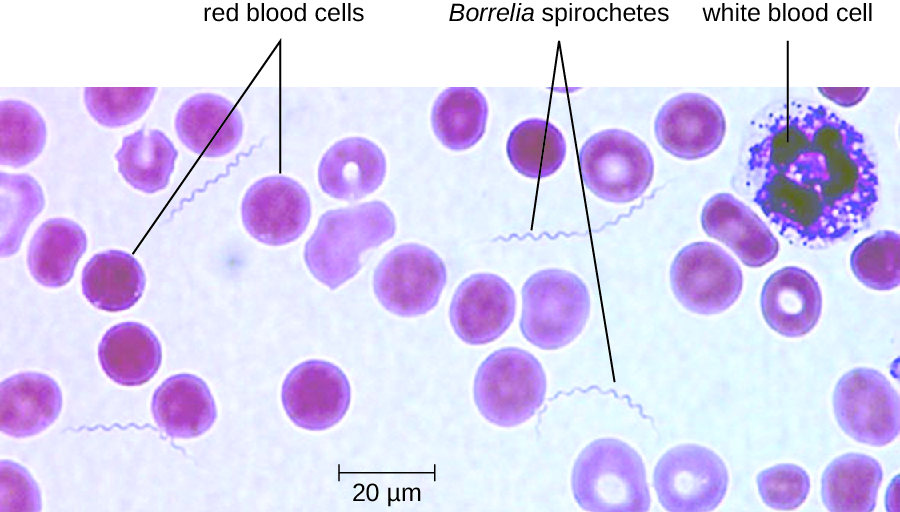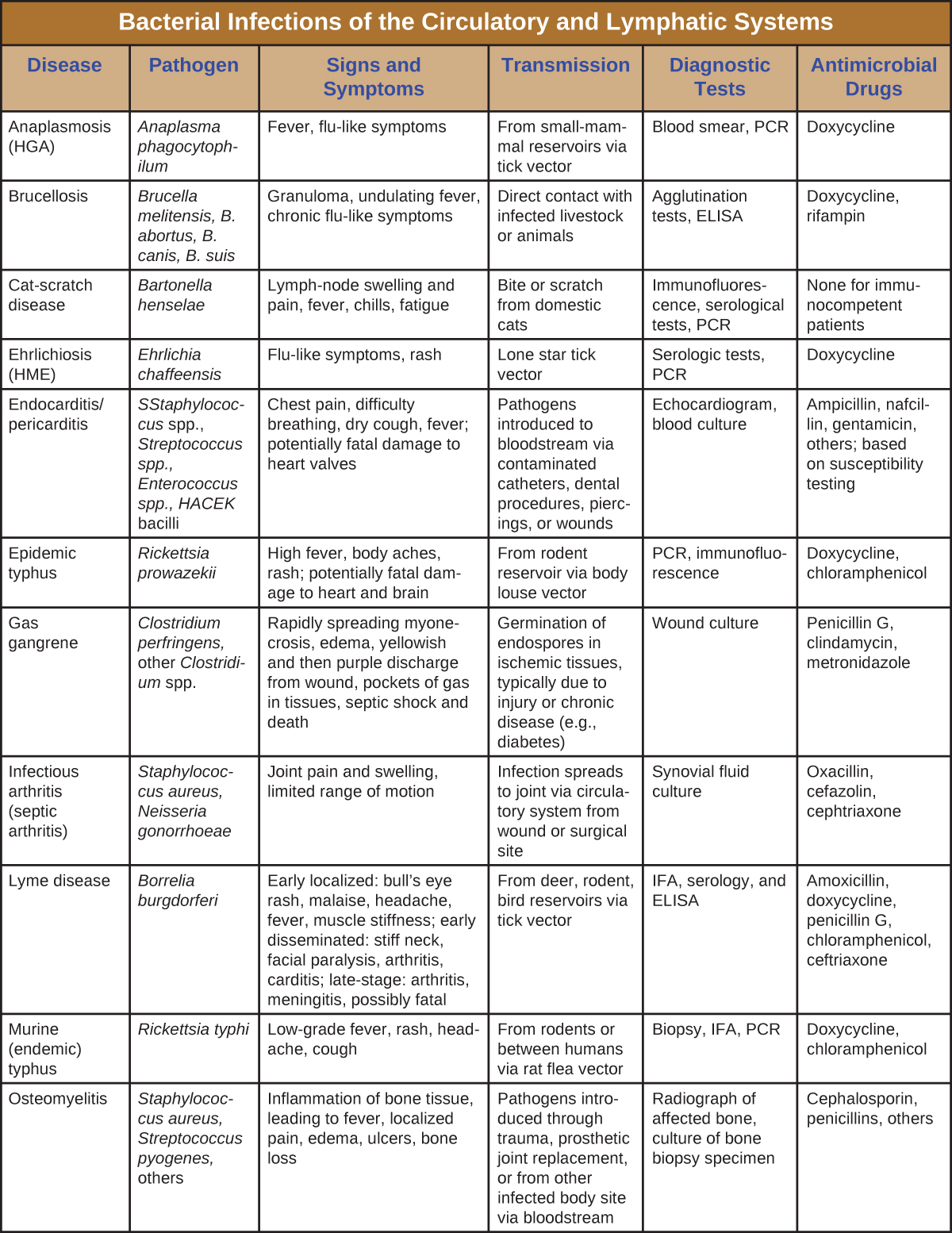| << Chapter < Page | Chapter >> Page > |
In both louse- and tickborne relapsing fevers, bacteremia usually occurs after the initial exposure, leading to a sudden high fever (39–43 °C [102.2–109.4 °F) typically accompanied by headache and muscle aches. After about 3 days, these symptoms typically subside, only to return again after about a week. After another 3 days, the symptoms subside again but return a week later, and this cycle may repeat several times unless it is disrupted by antibiotic treatment. Immune evasion through bacterial antigenic variation is responsible for the cyclical nature of the symptoms in these diseases.
The diagnosis of relapsing fever can be made by observation of spirochetes in blood, using darkfield microscopy ( [link] ). For louseborne relapsing fever, doxycycline or erythromycin are the first-line antibiotics. For tickborne relapsing fever, tetracycline or erythromycin are the first-line antibiotics.

The louseborne disease trench fever was first characterized as a specific disease during World War I, when approximately 1 million soldiers were infected. Today, it is primarily limited to areas of the developing world where poor sanitation and hygiene lead to infestations of lice (e.g., overpopulated urban areas and refugee camps). Trench fever is caused by the gram-negative bacterium Bartonella quintana , which is transmitted when feces from infected body lice, Pediculus humanus var corporis , are rubbed into the louse bite, abraded skin, or the conjunctiva. The symptoms typically follow a 5-day course marked by a high fever, body aches, conjunctivitis, ocular pain, severe headaches, and severe bone pain in the shins, neck, and back. Diagnosis can be made using blood cultures; serological tests like ELISA can be used to detect antibody titers to the pathogen and PCR can also be used. The first-line antibiotics are doxycycline , macrolide antibiotics , and ceftriaxone .
Many of the diseases covered in this chapter involve arthropod vectors. Of these, ticks are probably the most commonly encountered in the US. Adult ticks have eight legs and two body segments, the cephalothorax and the head ( [link] ). They typically range from 2 mm to 4 mm in length, and feed on the blood of the host by attaching themselves to the skin.
Unattached ticks should be removed and eliminated as soon as they are discovered. When removing a tick that has already attached itself, keep the following guidelines in mind to reduce the chances of exposure to pathogens:
Many ill-advised home remedies for tick removal have become popular in recent years, propagated by social media and pseudojournalism. Health professionals should discourage patients from resorting to any of the following methods, which are NOT recommended:

Although the circulatory system is a closed system, bacteria can enter the bloodstream through several routes. Wounds, animal bites, or other breaks in the skin and mucous membranes can result in the rapid dissemination of bacterial pathogens throughout the body. Localized infections may also spread to the bloodstream, causing serious and often fatal systemic infections. [link] and [link] summarize the major characteristics of bacterial infections of the circulatory and lymphatic systems.

![Table titled: Bacterial Infections of the Circulatory and Lymphatic Systems (continued). Columns: Disease, Pathogen, Signs and Symptoms, Transmission, Diagnostic Tests, Antimicrobial Drugs.Plague; Yersinia pestis; Bubonic: buboes, fever, internal hemorrhaging; septicemic: fever, abdominal pain, shock, DIC, necrosis in extremities; pneumonic: acute pneumonia, respiratory failure, shock. All forms have high mortality rates. Transmitted from mammal reservoirs via flea vectors or consumption of infected animal; transmission of pneumonic plague between humans via respiratory aerosols; Culture of bacteria from lymph, blood, or sputum samples; DFA, ELISA; Gentamycin, fluoroquinolones, others. Puerperal sepsis; Streptococcus pyogenes, many others; Rapid-onset fever, shock, and death; Pathogens introduced during or immediately following childbirth; Wound, urine, or blood culture; As determined by susceptibility testing. Rat-bite fever; Streptobacillus moniliformis, Spirillum minor; Fever, muscle and joint pain, rash, ulcer; Bite from infected rat or exposure to rat feces or body fluids in contaminated food or water; Observation of the organism from samples and antibody tests; Penicillin. Relapsing fever; Borrelia recurrentis, B. hermsii, other Borrelia spp.; Recurring fever, headache, muscle aches; From rodent or human reservoir via body louse or tick vector; Darkfield microscopy; Doxycycline, tetracycline, erythromycin. Rheumatic fever; Streptococcus pyogenes; Joint pain and swelling, inflammation and scarring of heart valves, heart murmur; Sequela of streptococcal pharyngitis; Serology, electrocardiogram, echocardiogram; Benzathine benzylpenicillin. Rocky Mountain spotted fever; Rickettsia rickettsia; High fever, headache, body aches, nausea and vomiting, petechial rash; potentially fatal hypotension and ischemia due to blood coagulation; From rodent reservoir via tick vectors; Biopsy, serology, PCR; Doxycycline, chloramphenicol. Toxic shock syndrome (TSS); Staphylococcus aureus; Sudden high fever, vomiting, diarrhea, hypotension, deathPathogens from localized infection spread to bloodstream; pathogens introduced on tampons or other intravaginal products; Serology, toxin identification from isolates; Clindamycin, vancomycin. Toxic shock-like syndrome (STSS); Streptococcus pyogenes; Sudden high fever, vomiting, diarrhea, acute respiratory distress syndrome (ARDS), hypoxemia, necrotizing fasciitis, death; Sequela of streptococcal skin or soft-tissue infection; [MISSING]; Penicillin, cephalosporin. Trench fever; Bartonella Quintana; High fever, conjunctivitis, ocular pain, headaches, severe pain in bones of shins, neck, and back; Between humans via body louse vector; Blood culture, ELISA, PCR; Doxycycline, macrolide antibiotics, ceftriaxone. Tularemia (rabbit fever); Francisella tularensis Skin lesions, fever, chills, headache, buboes; Eating or handling infected rabbit; transmission from infected animal via tick or fly vector; aerosol transmission (in laboratory or as bioweapon); DFA; Streptomycin, gentamycin, others.](/ocw/mirror/col12087/m58936/OSC_Microbio_25_02_BactCircDP_Part2.jpg)
Lyme disease is characterized by a(n) ________ that forms at the site of infection.
bull’s eye-rash
________ refers to a loss of blood pressure resulting from a system-wide infection.
Septic shock
What are the three forms of plague and how are they contracted?
Compare epidemic and murine typhus.

Notification Switch
Would you like to follow the 'Microbiology' conversation and receive update notifications?